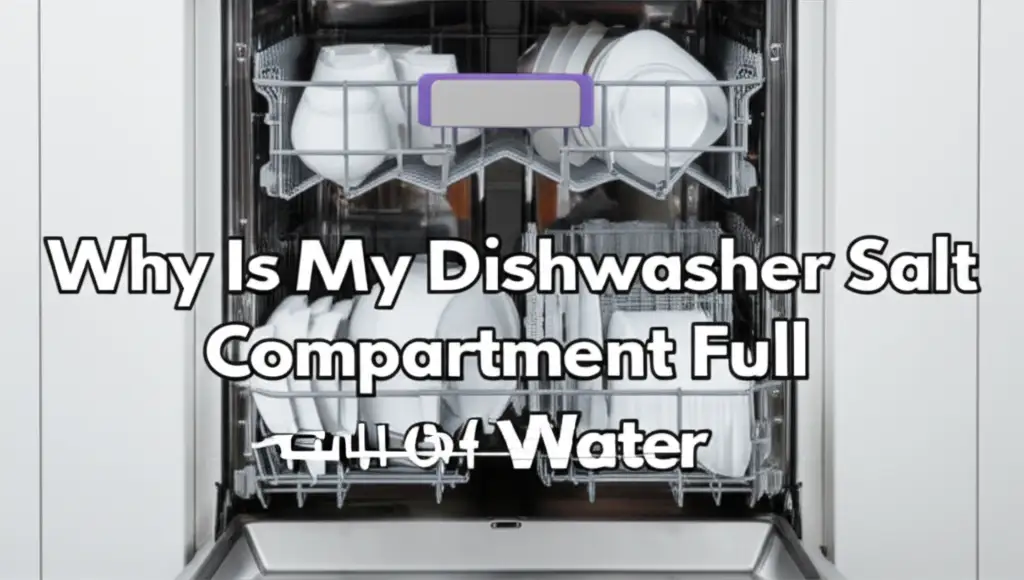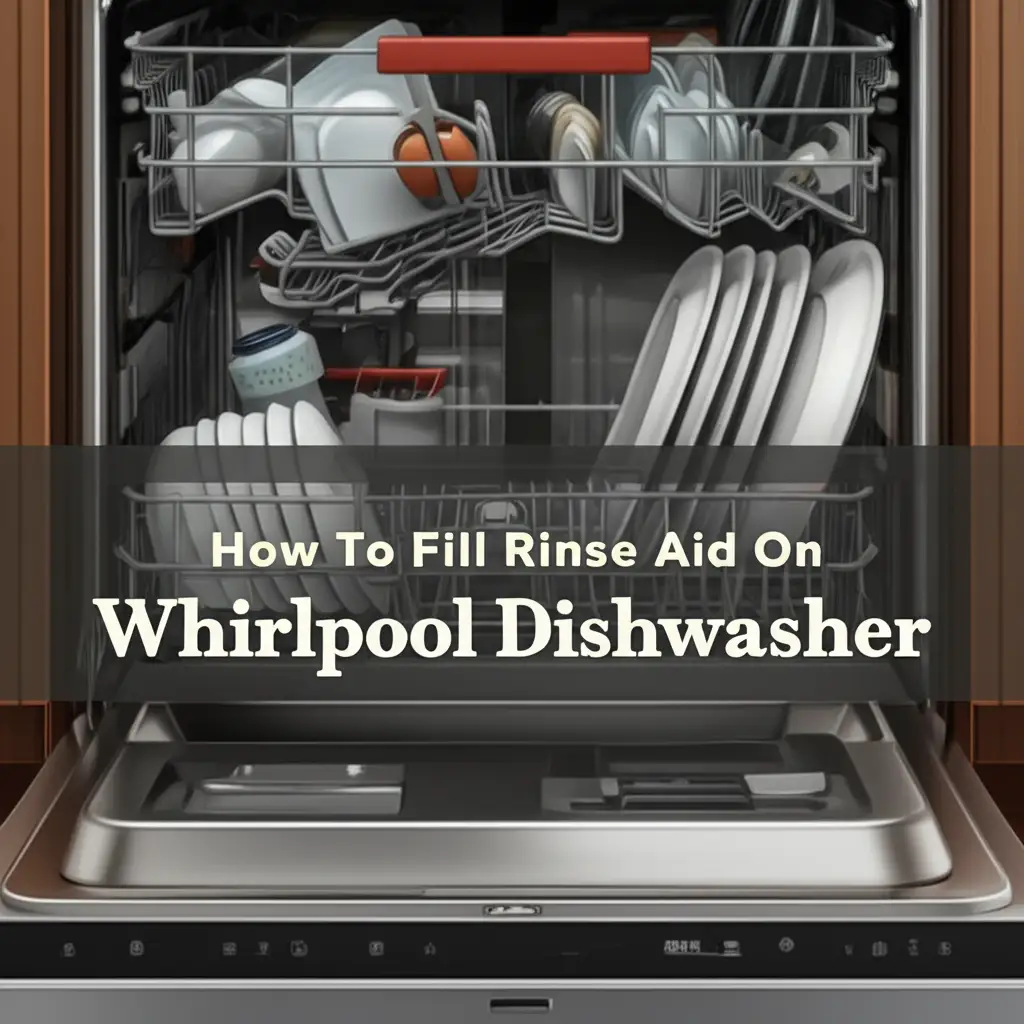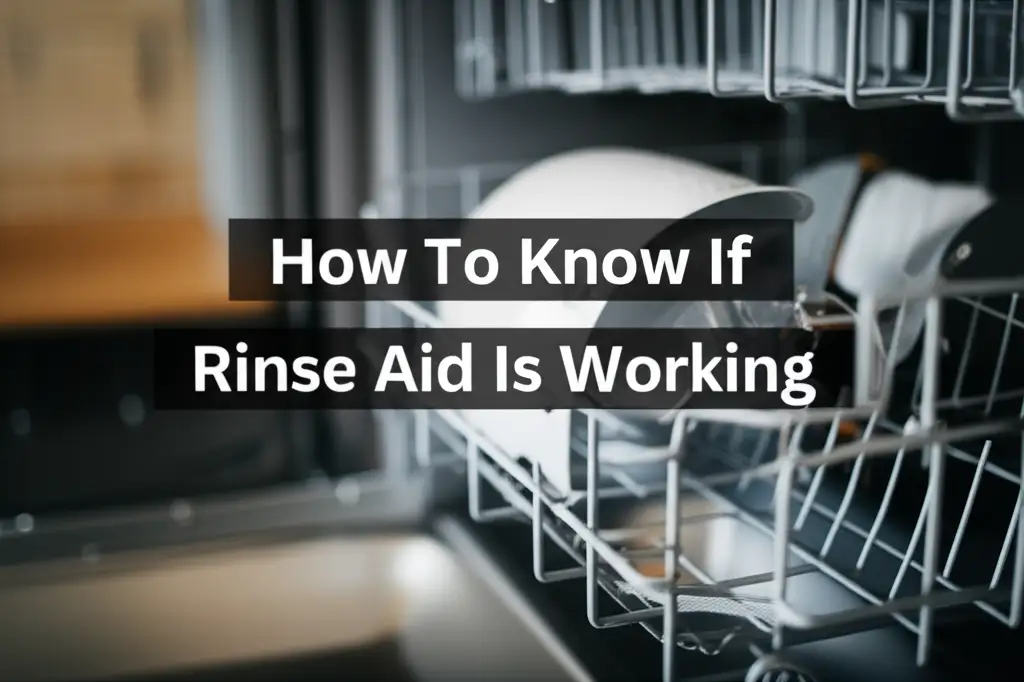· Katria Melrose · Dishwasher Maintenance · 21 min read
Why Is My Dishwasher Salt Compartment Full Of Water

Water in Dishwasher Salt Compartment? Here’s Why!
Imagine opening your dishwasher to add salt, only to find the salt compartment already full of water. This can be quite surprising. You might wonder, “Why is my dishwasher salt compartment full of water?” This is a common concern for many dishwasher owners, especially those living in hard water areas. The salt compartment is crucial for your dishwasher’s internal water softening system, ensuring your dishes come out spotlessly clean without mineral residue. When it fills unexpectedly, it indicates an issue that needs your attention.
In this comprehensive guide, I will explore the various reasons behind water accumulating in your dishwasher’s salt compartment. We will discuss everything from normal operation to common malfunctions, providing clear troubleshooting steps. My goal is to help you understand the problem and offer practical solutions. By the end of this article, you will know how to diagnose and resolve this issue, keeping your dishwasher running efficiently.
Takeaway
- The salt compartment usually holds some water; this is normal.
- Persistent overflow or unusual water levels point to a problem.
- Common causes include a loose cap, clogged air vent, or valve issues.
- Fixes often involve checking the cap, draining excess water, and cleaning.
- Regular maintenance helps prevent future problems.
Why Is My Dishwasher Salt Compartment Full Of Water?
The salt compartment in your dishwasher is designed to hold water. This water dissolves the specialized dishwasher salt, creating a brine solution. This solution then regenerates the dishwasher’s ion-exchange resin, which removes hardening minerals like calcium and magnesium from your wash water. If the compartment is overflowing or always full to the brim, it suggests an issue with the cap, a blocked air vent, or a malfunctioning water softener valve.
Understanding the Dishwasher Salt Compartment’s Function
Your dishwasher’s salt compartment plays a vital role in achieving sparkling clean dishes, especially if you have hard water. I know how frustrating it is to unload dishes covered in white spots. This is where the dishwasher salt comes in. It is not like regular table salt. It is a specialized, coarse-grain sodium chloride designed to soften the water inside your appliance.
The salt compartment itself is part of the dishwasher’s built-in water softening system. Hard water contains high levels of minerals such as calcium and magnesium. These minerals can leave unsightly spots on your dishes and glassware. Over time, they can also build up inside your dishwasher. This buildup reduces its efficiency and potentially shortens its lifespan. The salt compartment holds the dishwasher salt, which then dissolves into the water. This creates a brine solution. This solution is crucial for regenerating the ion-exchange resin beads within the dishwasher’s water softener. The resin beads capture the hard water minerals. The brine solution flushes these minerals away, allowing the resin to continue softening the water.
A common misunderstanding is that the salt compartment should be dry. This is incorrect. The compartment is designed to be full of water. This water allows the salt to dissolve slowly and continuously. It ensures the water softening system functions correctly during each wash cycle. My experience tells me that many people are surprised to find water there. They think it means something is wrong. However, it is a normal part of how the system operates. The key is to distinguish between normal water presence and an abnormal overflow. Understanding this basic function is the first step in diagnosing any issues. It helps you determine if what you are seeing is a problem at all.
Normal Water Levels vs. An Actual Problem
It is important to understand what is normal before troubleshooting your dishwasher. The salt compartment in your dishwasher is almost always full of water. This is by design. The water dissolves the special dishwasher salt, allowing it to work effectively. When you add new salt, you pour it into this water-filled reservoir. The water helps the salt gradually release into the softening system. This ensures continuous regeneration of the resin.
So, seeing water in the salt compartment is not a problem in itself. It is a sign that the system is operating as it should. The issue arises when the water level is excessive, or if it is visibly overflowing. For example, if water spills out when you open the cap, or if the compartment seems to be constantly overfilled beyond its normal capacity. A true problem exists when the water interferes with adding more salt. It also indicates an issue if it suggests a blockage or malfunction within the softening or drainage system.
My own observations have shown me that many users become concerned when they first notice water here. However, a properly functioning salt compartment will always have water. The concern should begin if the water is murky, exceptionally dirty, or if it is continuously rising and overflowing. Such symptoms indicate a deeper issue beyond simple presence of water. This distinction is vital for proper diagnosis. It prevents unnecessary worry or attempts to “fix” something that is not broken. When your dishwasher’s salt light comes on, it means the salt level is low, not that the water level is too high. You can learn more about this by reading our guide on why does my dishwasher salt light keep coming on.
Common Causes for Excessive Water Accumulation
When your dishwasher’s salt compartment is unexpectedly full or overflowing, several issues could be at play. It can be concerning to see water where you expect salt, even though some water is normal. My experience tells me that these problems usually stem from a few key areas. Each cause has its own specific symptoms and solutions. Identifying the exact cause is the first step toward a proper fix. Let’s break down the most common culprits behind this issue.
The Salt Compartment Cap Is Loose or Damaged
One of the simplest reasons for water overflowing from the salt compartment is a problem with its cap. This cap creates a seal, keeping the water inside the compartment during the wash cycle. If the cap is not screwed on tightly, it can allow water to leak out. This leads to an appearance of overflow. Similarly, if the cap is cracked, chipped, or has a worn rubber seal, it cannot form a proper watertight seal. This will also result in water escaping.
I have seen this issue many times. Users often forget to tighten the cap fully after refilling the salt. Or, over time, the plastic or rubber material of the cap can degrade. It might also become brittle due to heat and chemicals. This damage compromises its sealing ability. A damaged cap needs replacement. A loose cap simply needs tightening. Always ensure the cap is securely fastened after adding salt to prevent this common issue.
Overfilling the Salt Compartment
While it might seem counterintuitive, overfilling the salt compartment can also contribute to the appearance of too much water. When you add too much salt, it displaces the water already present. This causes the water to rise and potentially overflow from the opening. The salt then takes up more space than intended, pushing the water out. This is a common mistake when users are trying to ensure they have enough salt.
It is important to follow your dishwasher’s manual regarding the correct amount of salt to add. Typically, you fill the compartment until the salt is visible just below the neck. The remaining space is for the water. If you pack the salt in, there is less room for the water. The displaced water has nowhere to go but out. This creates a mess and gives the impression of an overflowing compartment. Always leave some space for the water. You can find more details on how to correctly fill the compartment by checking our guide on how to use Finish salt for dishwasher.
Clogged Air Vent or Dispenser Nozzle
The salt compartment, like many water-filled systems, needs an air vent to function properly. This vent allows air to escape as water enters or as the salt dissolves. If this air vent becomes clogged, it creates an airlock. This prevents proper water circulation. Water might then struggle to drain or fill correctly. This can lead to a backup of water within the compartment. This makes it appear fuller than it should be.
Similarly, the dispenser nozzle, through which the brine solution enters the water softening system, can also become clogged. Salt can sometimes clump or residue can build up, blocking this pathway. A blocked nozzle prevents the salt solution from being drawn out effectively. This then causes water to remain stagnant or build up in the compartment. Clearing these small pathways is crucial for the system to operate efficiently. I often find small salt crystals or mineral deposits as the culprits here.
Malfunctioning Water Softener Valve
The water softener unit in your dishwasher has a valve that controls the flow of water into and out of the salt compartment. This valve is designed to open at specific times during the wash cycle to allow water to dissolve the salt. It then closes to prevent continuous flow. If this valve becomes faulty, it might get stuck in an open position. This would allow water to continuously flow into the salt compartment. This leads to an excessive buildup of water.
A faulty valve can be a result of wear and tear, mineral deposits, or a mechanical defect. When the valve is not closing properly, water will constantly enter the compartment. This will lead to it being perpetually full or overflowing. This issue usually requires professional attention. It might involve disassembling part of the dishwasher to access and replace the valve. This is a more complex problem than a simple cap issue or clog.
Incorrect Salt Type or Quality
Using the wrong type of salt in your dishwasher can also lead to problems with water accumulation. Dishwashers require coarse-grain, specialized dishwasher salt. This salt is designed to dissolve slowly and evenly. It also contains no additives that could harm the dishwasher. If you use table salt, rock salt, or water softener salt meant for a whole-house system, it can cause issues. These salts dissolve too quickly or contain impurities.
Fine-grain salts, like table salt, dissolve rapidly and can form a dense, sludgy mass at the bottom of the compartment. This sludge can block the dispenser nozzle or air vent. This then impedes proper water flow. Impurities in non-dishwasher salt can also lead to mineral buildup or corrosion within the system. This further exacerbates blockages or valve malfunctions. Always ensure you are using high-quality, dedicated dishwasher salt for optimal performance and to prevent clogs and water issues. Many users ask about adding rinse aid and salt, and it’s essential to understand that they go in separate compartments. For more guidance, see our article on how to put rinse aid and salt in dishwasher.
Dishwasher Drainage Issues
While less directly related to the salt compartment itself, overall dishwasher drainage problems can indirectly affect water levels. If your dishwasher is not draining properly, water might back up into various compartments, including the salt reservoir. A clogged drain hose, a blocked filter, or a malfunctioning drain pump can all prevent water from exiting the dishwasher effectively. This leads to standing water inside the appliance.
When the dishwasher cannot drain, the water has nowhere to go. It can then seek the lowest points, including internal compartments like the salt dispenser. This might give the impression that the salt compartment is overflowing specifically. However, the root cause is a general drainage failure. If you also notice standing water at the bottom of your dishwasher tub after a cycle, it is a strong indicator of a drainage issue. This type of problem typically requires checking the drain filter, hose, and pump for obstructions or failures. You can find more information about this issue in articles like why does my LG dishwasher have water in the bottom.
Troubleshooting Steps for a Water-Filled Compartment
When you discover your dishwasher salt compartment is overly full of water, there are several troubleshooting steps you can take. I always recommend starting with the simplest solutions first. These steps can often resolve the issue without needing professional help. Follow these guidelines carefully to diagnose and fix the problem. My goal is to empower you to handle these common appliance quirks.
Step 1: Check the Salt Compartment Cap
The very first thing I check is the salt compartment cap. It is surprising how often this simple component is the culprit. A loose or improperly seated cap cannot create a tight seal. This allows water to escape or fill the compartment excessively.
- Action:
- Carefully unscrew the salt compartment cap. Be prepared for some water to possibly spill if it is truly overfilled.
- Inspect the cap thoroughly. Look for any visible cracks, chips, or damage to the plastic.
- Check the rubber gasket or seal around the cap’s rim. This seal is crucial for maintaining a watertight closure. Ensure it is not cracked, brittle, or twisted.
- Clean the cap and its threads. Sometimes, salt residue can build up on the threads. This prevents the cap from screwing on properly.
- Screw the cap back on firmly. Make sure it is hand-tight. Do not overtighten it, as this can damage the cap or the compartment threads.
If the cap is damaged, you will need to replace it. Finding a replacement cap specific to your dishwasher model is usually easy.
Step 2: Remove Excess Water and Inspect for Blockages
If the cap is fine, or if you still suspect an overflow, the next step is to carefully remove some water. This allows you to better inspect the compartment. It also helps in identifying any blockages.
- Action:
- Use a sponge, turkey baster, or small cup to carefully scoop out excess water from the salt compartment. Be gentle to avoid dislodging any internal components.
- Once the water level is lower, use a flashlight to look inside the compartment.
- Inspect the opening of the air vent. This is usually a small hole or channel located near the top rim or side of the compartment. Look for any salt residue, mineral buildup, or foreign debris blocking it.
- Examine the salt dispenser nozzle. This is the outlet where the dissolved salt solution exits the compartment. It is typically at the bottom. Check for any clogs from undissolved salt, sludge, or other particles.
- If you find a blockage, use a thin, non-metal object like a toothpick or a plastic straw to gently clear it. Be careful not to push debris further into the system. Avoid using metal tools, as they can damage plastic components.
After clearing any blockages, add the correct amount of fresh dishwasher salt if needed. Then, refill the compartment with water as per your dishwasher’s instructions, and securely replace the cap.
Step 3: Check for General Dishwasher Drainage Issues
As I mentioned earlier, general drainage problems can sometimes manifest as water in the salt compartment. If the dishwasher isn’t draining correctly, water can pool in the tub and potentially back up into the salt reservoir.
- Action:
- After a wash cycle, open your dishwasher door. Check for any standing water at the bottom of the tub. If there is water, it indicates a drainage problem.
- Inspect the Dishwasher Filter: Most dishwashers have a filter at the bottom of the tub that collects food debris. Locate and remove this filter (refer to your manual for exact location and removal steps). Clean it thoroughly under running water, removing all food particles and grease.
- Check the Drain Hose: The drain hose connects your dishwasher to the sink drain or garbage disposal. Look for any kinks, twists, or obvious blockages in the hose. If possible, disconnect it (ensure water supply is off first) and check for clogs.
- Listen to the Drain Pump: During a wash cycle’s drain phase, listen for the sound of the drain pump. If you hear nothing or unusual noises, the pump might be failing.
If you identify a significant drainage issue, addressing it first might resolve the salt compartment problem too. Addressing drainage problems can be involved. For specific brand issues, you might consult guides like why does my Whirlpool dishwasher have water in the bottom or for other brands too.
Step 4: Consider the Water Softener Valve
If you’ve tried the above steps and the issue persists, the problem might lie with the dishwasher’s internal water softener valve. This is a more complex issue. It often requires professional diagnosis.
- Symptoms of a faulty valve: The salt compartment is consistently overfilled, even after clearing blockages and ensuring the cap is secure. You might hear water continuously running into the compartment when the dishwasher is off, or at unusual times.
- Action: While a user can’t easily “fix” a faulty valve, you can try resetting your dishwasher by unplugging it for 5-10 minutes. This might clear minor electronic glitches. If the problem persists, it is best to consult your dishwasher’s service manual or contact a qualified appliance technician. A malfunctioning valve might need replacement. This typically involves disassembling parts of the dishwasher’s base.
By systematically working through these troubleshooting steps, you can often pinpoint the exact reason why your dishwasher salt compartment is full of water and implement an effective solution.
Preventative Measures and Maintenance Tips
Preventing issues with your dishwasher’s salt compartment is often easier than fixing them. Regular maintenance and adherence to proper usage guidelines can save you a lot of hassle. I always advise my friends to incorporate these simple habits into their routine. This helps ensure their dishwasher runs smoothly and efficiently for years to come. These preventative measures focus on correct usage, the right materials, and routine checks.
Use the Correct Type of Dishwasher Salt
This is perhaps the most critical preventative measure. Not all salts are created equal. Using anything other than specialized dishwasher salt can cause serious problems.
- Why it matters: Dishwasher salt is specifically designed to be highly pure sodium chloride with large granules. This purity prevents undesirable residues and clogs within the softening unit. Its coarse texture ensures slow, even dissolution. Table salt, for example, contains anti-caking agents that can damage your dishwasher. It also dissolves too quickly, leading to clumping and blockages. Water softener salts for whole-house systems are also different. They are not formulated for dishwasher use.
- Action: Always purchase and use high-quality dishwasher salt. Check your dishwasher’s manual for any specific recommendations from the manufacturer. This simple step avoids many common issues with the salt compartment.
Do Not Overfill the Salt Compartment
While it might seem logical to fill the salt compartment to the brim, it can actually lead to problems, including the appearance of an overflowing compartment.
- Why it matters: The compartment needs space for both the salt and the water that dissolves it. Overfilling with salt displaces the water. This can cause it to rise and spill. It can also compact the salt, making it harder for water to circulate and dissolve the salt properly.
- Action: Follow your dishwasher’s instructions for filling the salt compartment. Generally, you fill it with salt until it reaches just below the neck or fill line indicator. Then, you allow the existing water to cover the salt. This ensures there is adequate space for proper operation.
Ensure the Salt Compartment Cap is Secure
A loose or damaged cap is a leading cause of water leakage and compartment issues. It is a simple fix, but often overlooked.
- Why it matters: The cap forms a watertight seal. This prevents water from escaping during the wash cycle. If it’s loose, water can seep out, creating a mess and indicating an “overflow” that isn’t really a malfunction of the softening system itself. A damaged seal can also allow foreign particles into the compartment.
- Action: After every salt refill, ensure the cap is screwed on tightly and correctly. Check the cap and its rubber seal periodically for any signs of wear, cracks, or damage. Replace the cap if it shows any signs of deterioration.
Regular Cleaning and Inspection of the Compartment
Even with proper salt and careful filling, minor blockages can occur over time. Regular visual inspections and occasional gentle cleaning can prevent these.
- Why it matters: Salt residue, mineral deposits from hard water, or small debris can accumulate. This clogs the air vent or the dispenser nozzle. These blockages prevent proper water flow and salt dissolution.
- Action: When you refill the salt, take a moment to visually inspect the compartment’s interior. Look for any visible obstructions in the air vent or nozzle. If you see buildup, use a toothpick or a non-abrasive brush to gently clear it. You can also carefully use a turkey baster to remove any murky water or residue if the compartment looks particularly dirty.
Monitor Dishwasher Performance
Paying attention to how your dishwasher runs can give you early warning signs of problems.
- Why it matters: If your dishes start coming out spotty or cloudy despite having salt in the compartment, it could indicate that the water softening system is not working effectively. This might be due to a valve issue or a persistent blockage.
- Action: Regularly check your dishes for cleanliness and absence of mineral spots. If you notice a decline in performance, investigate the salt compartment and softening system first. Early detection can prevent more severe issues down the line.
By implementing these straightforward preventative measures, you can significantly reduce the likelihood of your dishwasher salt compartment becoming excessively full of water. This ensures your dishwasher remains a reliable workhorse in your kitchen.
When to Call a Professional Appliance Technician
While many issues with a dishwasher’s salt compartment can be resolved with simple troubleshooting, there are times when professional help becomes necessary. I always recommend knowing your limits when it comes to appliance repair. Trying to fix a complex problem yourself can sometimes lead to more damage or even personal injury. Knowing when to call in an expert saves you time, frustration, and potentially more money in the long run.
- Persistent Overflow After Basic Troubleshooting: If you have already checked the cap, cleared any visible blockages, ensured you are using the correct salt, and the compartment still fills excessively or overflows, it points to a deeper issue. This often indicates a problem with an internal component that you cannot easily access or diagnose.
- Suspected Faulty Water Softener Valve: A malfunctioning water softener valve is a common culprit for continuous overfilling. This valve controls water flow into the salt compartment. If it is stuck open or not functioning correctly, water will keep entering. Replacing this valve requires specific tools and technical knowledge. It often involves disassembling parts of the dishwasher’s base. This is a job best left to trained technicians.
- Electronic Control Board Issues: In some cases, the problem might stem from the dishwasher’s electronic control board. This board governs the timing and function of various components, including the water softener system. A faulty board might send incorrect signals, leading to continuous water filling. Diagnosing and replacing a control board is complex. It requires specialized diagnostic tools and expertise.
- Unusual Noises or Behaviors: If you hear strange noises, such as continuous humming or gurgling, even when the dishwasher is off, it might indicate a problem with a valve or pump. Any unusual operational behavior that you cannot explain through simple troubleshooting warrants a professional look.
- Warranty Considerations: If your dishwasher is still under warranty, attempting complex repairs yourself might void the warranty. In such cases, it is always best to contact the manufacturer’s authorized service center. They can provide repair services without invalidating your coverage.
- Lack of Tools or Confidence: If you do not have the right tools, or if you feel uncomfortable disassembling parts of your dishwasher, do not hesitate to call a professional. Appliance repair can be intricate. It requires a good understanding of electrical and plumbing systems.
A professional technician has the experience, diagnostic tools, and access to genuine replacement parts. They can accurately pinpoint the problem and repair it safely and effectively. While there’s a cost involved, it ensures the job is done right. It also prevents further damage to your valuable appliance. Consider it an investment in your dishwasher’s longevity and performance.
Frequently Asked Questions (FAQ)
Q1: Is it normal for my dishwasher’s salt compartment to have water in it?
Yes, it is completely normal. The salt compartment is designed to be full of water. This water dissolves the specialized dishwasher salt, which is essential for regenerating the water softening system. The water creates a brine solution that flushes away hard water minerals, ensuring your dishes come out clean.
Q2: What kind of salt should I use in my dishwasher?
You must use coarse-grain, specialized dishwasher salt. Do not use table salt, rock salt, or water softener salt meant for whole-house systems. These other salts can contain impurities or dissolve too quickly, leading to clogs or damage to your dishwasher’s internal components. Always check your dishwasher manual for specific recommendations.
Q3: How do I add salt to a compartment that is already full of water?
Simply pour the recommended amount of dishwasher salt directly into the water-filled compartment. The salt is denser than water and will sink to the bottom. The water will displace and may overflow slightly, which is normal. Replace the cap securely afterward.
- dishwasher salt
- water in salt compartment
- dishwasher repair
- hard water
- appliance maintenance
- dishwasher troubleshooting
- salt dispenser





